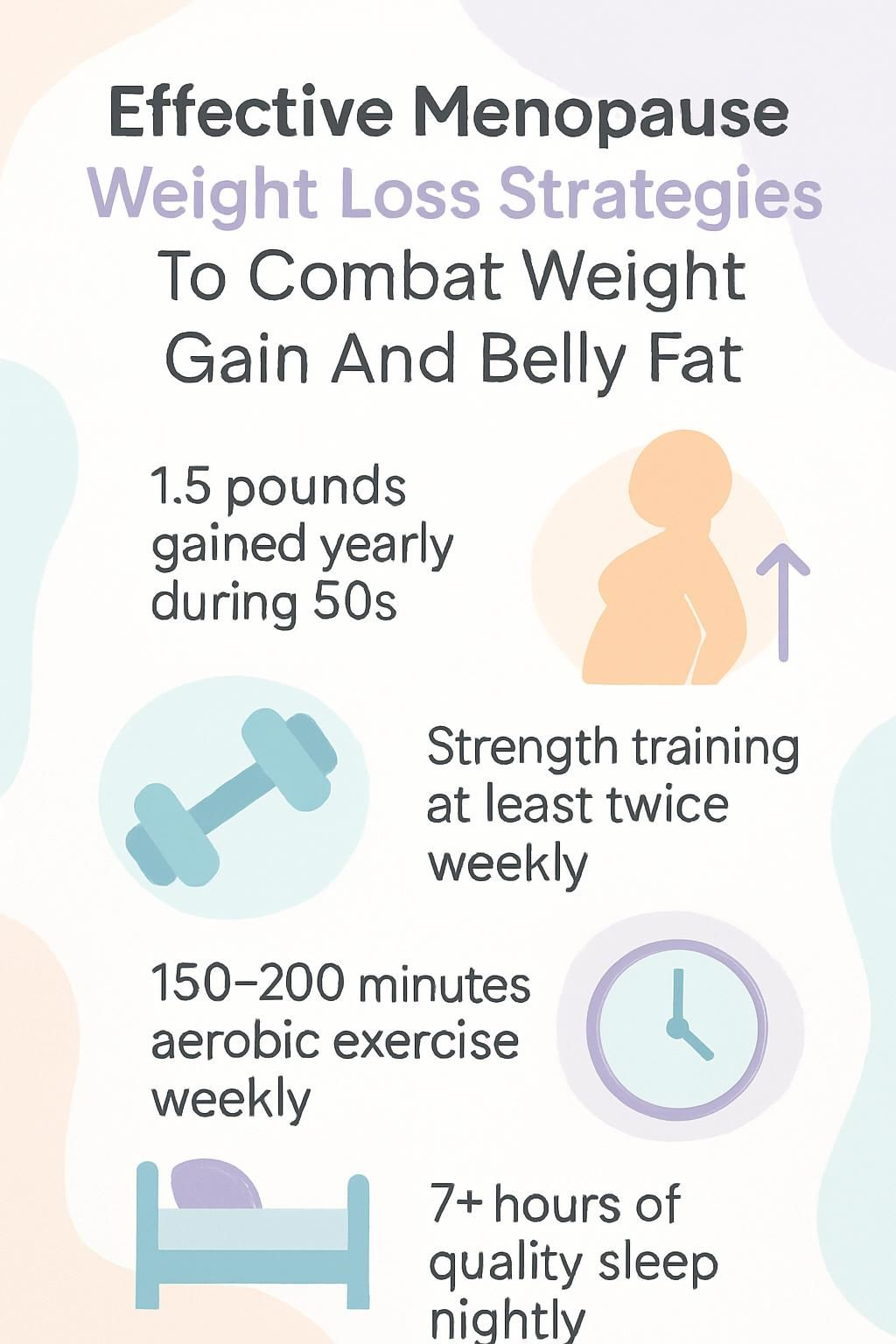Effective Menopause Weight Loss Strategies To Combat Weight Gain And Belly Fat
Our Nutrition Assistant AI Suite will transform your body. You will lose fat, get toned, and build muscle. Gain confidence and optimal health.
If midlife brought extra weight or a thicker waist, you are in good company. Many women notice belly fat during the menopausal transition as hormones shift. This guide shares practical menopause weight loss strategies to help you manage body weight and reduce belly fat with steady, healthy steps.
Use these science-backed tips to start small changes today. Simple moves can build real momentum over time.
Key Takeaways
- Perimenopause, the years before your final period, often starts weight gain. On average, women gain about 1.5 pounds per year in their 50s as estrogen drops and muscle mass declines.
- Belly fat and a slower metabolism raise the risk of heart disease, diabetes, and joint pain. More abdominal fat is directly linked to higher cardiovascular risk, according to the American Heart Association.
- Helpful steps include eating mostly whole foods, cutting sugar and refined carbs, watching portions, choosing healthy fats like olive oil, and doing strength training twice a week.
- Aerobic exercise, 150 to 200 minutes weekly, plus short HIIT sessions, yoga for stress, good sleep of 7 or more hours, hydration, and mindful eating all support weight management in midlife.
- Hormone therapy may ease symptoms but is not a weight loss treatment. Discuss HRT and any prescription weight loss drugs with a clinician who can monitor safety.

Menopause and Weight Gain: Key Facts

Weight often shifts to the midsection during the menopausal transition. Changing levels of estrogen and progesterone, the key female hormones, drive much of this change in body shape and fat storage.
When does menopause weight gain typically begin?
For many, weight gain starts in perimenopause. This phase usually begins in your 40s and can last 7 to 10 years. Estrogen levels rise and fall, then trend lower.
You may see the number on the scale climb or notice tighter waistbands. Typical gain averages about 1.5 pounds per year during your 50s.
At the same time, you lose muscle. Less muscle slows your metabolism, so you burn fewer calories at rest. Body shape can change even if your diet and exercise look the same.
You might be surprised by how quickly your jeans fit differently in your mid-40s.
These shifts signal perimenopause. Start paying attention to nutrition and habits early so small changes do not snowball.
What causes weight gain during menopause?
Falling estrogen and progesterone play a central role. As estrogen drops, fat tends to shift to your abdomen. Aging reduces basal metabolic rate, which is the calories you burn at rest. Losing skeletal muscle lowers it further.
A sedentary lifestyle, more processed foods, and sugary drinks add calories. Poor sleep can disrupt appetite hormones, which raises hunger and cravings. High stress spikes cortisol, a stress hormone, which can drive belly fat. These factors raise the risk of obesity, heart disease, and diabetes in postmenopausal years.
Why does menopause increase belly fat specifically?
With lower estrogen, your body changes where it stores fat. More gets stored around the abdomen, even if total weight changes slowly. Before menopause, fat often settled more in hips and thighs.
Muscle loss makes this worse because less muscle means fewer calories burned daily. Family history matters too. If your mother carried more belly fat after 45, you may see a similar pattern. Hormone therapy may help some women with fat distribution, but it needs medical guidance. More belly fat raises the risk of diabetes, high blood pressure, heart disease, and metabolic syndrome.
Health Risks from Weight Gain in Menopause
Extra weight in midlife can strain your heart, raise disease risk, and reduce quality of life. Joints can ache more when they carry extra load.
How does menopause weight gain affect heart health?
After menopause, lower estrogen changes fat storage and blood vessels. More belly fat increases the chance of high blood pressure, stroke, and heart disease. The American Heart Association notes that postmenopausal women face higher heart risk than men of the same age.
Eating a Mediterranean-style diet, rich in plants and olive oil, supports heart health. Many women see better cholesterol and blood pressure with this approach.
Maintaining a healthy weight is key for protecting your heart as you age,
says Dr. Lisa Mosconi, author of The XX Brain (2020).
Increasing physical activity lowers your chances of serious heart problems later in life.
What is the link between menopause weight gain and diabetes?
Gaining belly fat raises insulin resistance, which makes it harder to control blood sugar. As estrogen levels drop, more fat gathers around the abdomen. That fat disrupts how insulin works.
Women with more belly fat in their late 40s and early 50s have higher odds of prediabetes and type 2 diabetes after 50. Weight loss, even modest loss, improves blood sugars. Focus on whole foods, fiber, fish, nuts, and fewer sugary drinks. Regular checkups help track progress and adjust your plan.
How does weight gain impact bones and joint pain during menopause?
Extra pounds increase stress on knees, hips, and the lower back. Pain can rise, and arthritis can progress faster. At the same time, lower estrogen can speed bone loss and raise the risk of osteoporosis, a disease where bones become weak and break more easily.
Small weight gains can still worsen joint pain during daily tasks. Strength training, steady movement, and nutrient-dense meals protect bone density and support healthy joints through menopause.
Diet Approaches for Losing Weight in Menopause
Food choices are a powerful lever. A clear, simple plan helps you lose weight during menopause and supports long-term health.
Which whole, unprocessed foods help with menopause weight loss?
Whole foods are filling and nutrient rich. They help curb hunger while lowering disease risk.
- Fill your plate with vegetables like leafy greens, broccoli, and bell peppers. They are low in calories and high in fiber.
- Choose fruits such as berries and apples. They satisfy a sweet tooth with fewer calories than chips or cookies.
- Pick whole grains like quinoa, brown rice, and oats instead of refined grains. Whole grains support steady energy and a healthier metabolism.
- Add legumes, including lentils, chickpeas, and black beans. They provide protein that helps preserve muscle during aging.
- Use lean proteins like skinless poultry, eggs, tofu, and fish. Salmon offers omega-3 fats that support heart health.
- Snack on a small portion of nuts, such as almonds or walnuts. They increase fullness without large blood sugar swings.
- Cook with olive oil rather than butter. This choice pairs well with a Mediterranean-style eating pattern linked to less belly fat.
- Include fermented foods like plain yogurt or kefir. They support digestion and may ease bloating.
A varied mix of these foods supports steady progress, good energy, and a better mood. Many women find this pattern easier to sustain than a strict diet.
How can healthy fats support weight management?
Healthy fats from nuts, seeds, fish, and plants help you feel full longer. That can curb snacking and manage hunger. Diets rich in these fats, such as the Mediterranean diet, support weight control and heart health. Replacing butter with olive oil reduces saturated fat without losing flavor.
Choose fats that come in whole foods whenever possible. Avoid products that are labeled fat-free but loaded with sugar. Enjoy fats in moderate portions since all fats add calories.
Simple ideas include adding avocado to salads, sprinkling walnuts on oatmeal, or baking salmon once a week.
Why reduce sugar and refined carbs during menopause?
Added sugars and refined carbohydrates, like white bread and pastries, quickly raise blood sugar. That can lead to fat storage and more cravings. Many people get roughly 300 calories per day from added sugars, often from soda, sweets, and ice cream.
Cutting these foods helps with weight loss and steadier energy. Swapping soda for water or unsweetened tea is a small shift with a big payoff. Prioritizing whole foods sets the stage for easier portion control.
How to control portion sizes effectively?
Portion control is a quiet superpower. These simple tactics reduce overeating without complex rules.
- Trim about 200 calories per day from your usual intake. Metabolism slows with age, so this buffer helps.
- Use smaller plates to nudge smaller servings. People eat less when plates look full.
- Measure calorie-dense foods like nuts, oils, and cheese. A food scale or measuring cups prevent accidental overserves.
- Prioritize portion limits with oils, processed snacks, and alcohol. These add up fast.
- Eat mindfully. Chew slowly and watch hunger cues, especially when stressed.
- Fill half your plate with vegetables. They add volume and fiber for few calories.
- Pre-pack single-serving snacks for work or travel. It helps prevent grazing.
- Turn off screens during meals. Fewer distractions help you notice fullness.
- Wait 10 minutes before seconds. Give your brain time to catch up to your stomach.
Exercise Techniques to Reduce Weight and Belly Fat
Movement helps you hold the line on weight and can reshape how your body stores fat. Think of exercise as your daily vote for health.
Why is strength training important for menopausal women?
Muscle naturally declines with age. Less muscle means a slower metabolism and easier weight gain. Strength training, like lifting weights or using resistance bands, helps you keep and build muscle.
More muscle raises the calories you burn at rest. Aim for strength sessions at least two days per week. Many women also notice better posture, fewer aches, and higher energy after a few months of consistent training.
What aerobic exercises are best for menopause weight loss?
Aerobic exercise burns calories and supports heart health. Mix activities you enjoy to stay consistent.
- Brisk walking is joint friendly and effective. A faster pace boosts fat burn.
- Jogging improves fitness and calorie burn. It can help reduce waist size.
- Swimming works the whole body with little joint stress.
- Cycling is adjustable for any level and supports heart health.
- Dancing lifts mood while burning calories.
- Group fitness classes, like Zumba or step, add structure and motivation.
- Hiking adds hills and nature for extra effort and stress relief.
Target 150 to 200 minutes of moderate activity, like walking or cycling, each week. Or do at least 75 minutes of vigorous activity, like jogging.
How does HIIT help burn fat effectively?
High-Intensity Interval Training, or HIIT, alternates short bursts of effort with brief rests. These workouts spike your heart rate, then keep your metabolism elevated for hours. Research shows HIIT can burn similar or more calories in less time than steady-state cardio.
HIIT works both your aerobic and anaerobic systems. Even 15 to 30 minutes is helpful. One or two short HIIT sessions per week, plus strength training, is a powerful combo for trimming belly fat.
Can yoga reduce stress and aid weight loss?
Yoga calms the nervous system and lowers cortisol, the main stress hormone. High cortisol can drive belly fat. Regular practice supports better sleep, more mindful eating, and steadier moods.
Core-focused poses also build strength and balance. A weekly class or short home practice can improve both mental health and weight control during menopause.
Lifestyle Changes to Support Weight Loss
Daily habits shape your metabolism and appetite. Small steps build into strong routines over time.
How does quality sleep influence hormone balance and weight?
Sleep regulates leptin and ghrelin, the hormones that signal fullness and hunger. Poor sleep raises hunger, cravings, and late-night snacking. That makes weight gain more likely.
Good sleep also supports your exercise plan. Adults who sleep less than 7 hours per night gain more belly fat. Aim for 7 to 9 hours to support hormone balance and weight management.
What are effective stress management techniques like mindfulness?
Stress can push you toward overeating and belly fat. Simple tools can lower cortisol and support calm.
- Practice mindfulness for five minutes a day. Focus on your breath and let thoughts pass.
- Use a guided meditation app to build a steady routine.
- Try slow deep breathing when you feel tense. It lowers heart rate and cravings.
- Attend a weekly gentle yoga class for movement and relaxation.
- Take 10-minute walks outdoors after meals to clear your head.
- Write down three good moments each evening. Gratitude builds resilience.
- Shut down screens an hour before bed. Blue light interferes with melatonin, your sleep hormone.
Even a short daily practice can cut stress eating more effectively than willpower alone.
Why is hydration important and how does alcohol affect weight?
Water helps your metabolism work well and keeps appetite in check. Thirst often feels like hunger, which can trigger overeating. Staying hydrated supports digestion, energy, and exercise.
Alcohol adds extra calories with few nutrients. A 5 ounce glass of wine or a 12 ounce beer can slow progress if you are trying to lose weight. Moderate intake is advised for heart health, but limiting alcohol often makes a calorie deficit easier. Many women do well swapping evening drinks for sparkling water with lime.
Hormone Therapy’s Role in Managing Weight
Hormone therapy can ease hot flashes and sleep problems. Its impact on weight is limited and varies by person.
Can hormone therapy help prevent or reduce menopause weight gain?
Hormone therapy may slightly affect where your body stores fat. Some women sleep better and feel more active once hot flashes improve, which can support weight management. Still, HRT is not a weight loss treatment.
If belly fat is a concern, talk with your clinician. A specialist can explain whether hormone therapy fits your health goals, your history, and your symptom pattern.
What are the risks and benefits of hormone replacement therapy (HRT)?
Benefits include relief from hot flashes, night sweats, and sleep disruption. The North American Menopause Society 2022 statement supports HRT for healthy women under 60, or within 10 years of their last period, who have moderate to severe symptoms.
Risks can include bloating, headaches, and breast tenderness. Some women have higher risks for blood clots, stroke, or breast cancer with certain regimens. Decisions should be personalized with your doctor. Use the lowest effective dose for the shortest time that manages symptoms.
Medications and Weight Loss Support
Prescription weight loss drugs may help some menopausal women with higher BMI or related health issues. These medicines work best with a healthy diet and regular physical activity.
What weight-loss medications are available for menopausal women?
Doctors may consider medication if your BMI is 30 or higher, or 27 or higher with conditions like diabetes or high blood pressure.
- Orlistat reduces the fat your body absorbs from food. It must be paired with a reduced-calorie diet.
- Phentermine-topiramate can lower appetite and increase fullness. It needs ongoing medical monitoring.
- GLP-1 medicines, such as semaglutide, help control appetite and improve blood sugar. These require a prescription and follow-up.
- Your health history guides the choice. Heart disease, mental health, and other conditions affect what is safe.
- Medication follows lifestyle steps. Portion control, whole foods, and strength training come first.
- Pills are not quick fixes. You still need a plan for food, movement, and sleep.
- All prescriptions require medical supervision to watch for side effects and adjust dosing.
Close follow-up improves safety and helps you build long-term habits while using these tools.
Why is medical supervision crucial when using weight loss drugs?
Weight loss drugs can cause side effects like nausea or diarrhea. Medical supervision helps you manage problems early and avoid serious complications. Many people regain weight after stopping medication, so expert support sets realistic goals and a maintenance plan.
Your clinician will review your medical history, check for risks, and monitor progress with lab tests and visits. This careful approach improves safety while you work on losing belly fat in midlife.
Managing Metabolic Changes During Menopause
Metabolism often slows after menopause. Understanding why it happens helps you target the right levers.
How does menopause slow metabolism?
Muscle loss lowers your basal metabolic rate, the calories you burn at rest. Hormone changes, especially a drop in estrogen, also reduce how well your body uses fat for energy. More fat gets stored around the waist.
Lower daily activity worsens the slowdown. When you move less, muscles shrink faster, which further reduces calorie burn. These changes explain how weight gain becomes more common after 45 or 50.
What natural strategies boost metabolism after menopause?
Target the habits that protect muscle and steady blood sugar. These strategies support a healthier metabolic rate.
- Eat 20 to 30 grams of protein at each meal to protect muscle. Try poultry, fish, beans, or Greek yogurt.
- Do strength training 2 to 3 days per week with bands or free weights. Preserving lean mass keeps resting metabolism higher.
- Choose whole foods rich in fiber, like greens, berries, whole grains, and lean proteins. They help you stay full and energized.
- Include healthy fats from avocados, nuts, seeds, and olive oil. They support hormone balance and steady appetite.
- Aim for 150 minutes of moderate activity weekly, such as brisk walking or cycling. It supports weight and heart health.
- Reduce sugar and refined carbs to avoid blood sugar spikes, which can slow fat burning over time.
- Lower stress with yoga or mindfulness. Chronic stress hormones slow metabolism and increase fat storage.
- Sleep 7 to 9 hours nightly. Poor sleep disrupts appetite hormones and fat storage signals.
- Drink water often. Proper hydration supports the cell processes that power metabolism.
Staying Motivated While Losing Weight in Menopause
Motivation grows with clear goals and small wins. Treat this as a steady project, not a race.
How to set realistic and achievable weight loss goals?
Reachable goals build confidence. Aim for steady change, not a crash plan.
- Set incremental targets like 5 to 10 pounds first, then reassess.
- Include health goals such as lower cholesterol or less joint pain.
- Aim to lose 1 to 2 pounds per week, a safe pace backed by major clinics.
- Write goals and review them weekly to stay accountable.
- Make small swaps, like an extra serving of vegetables or a 15-minute walk.
- Track meals, steps, sleep, and mood to find helpful patterns.
- Celebrate non-scale wins like looser waistbands or better energy.
Once goals are set, you can track progress and adjust as needed.
What are effective ways to track progress and celebrate wins?
Tracking keeps you engaged and reveals what works. Small rewards help the new habits stick.
- Use a journal or app to log weight, workouts, and meals. Review weekly trends.
- Measure waist, hips, and thighs monthly. Inches often change before the scale does.
- Record victories beyond weight, like better sleep or easier stairs.
- Mark milestones, such as five pounds lost or two weeks of planned meals. Reward yourself with healthy treats like a new book or a nature walk.
- Share wins with a friend or group for extra accountability.
- Post visual reminders, like before and after photos or inspiring notes.
- Review your notes every two weeks and adjust your plan based on what you learn.
- Tracking energy levels can reveal links between food choices and how you feel.
How can building a support system improve motivation?
Support makes change easier. Friends, family, or a group can keep you accountable and encouraged. A walking buddy or a class can turn exercise into social time, which improves consistency.
Group support also helps during plateaus. People who have community support are more likely to maintain weight loss over time.
Common Misconceptions About Menopause Weight Loss
Myths can waste time and money. Clear facts help you focus on what works.
What are the myths about fad diets and quick fixes?
Fad diets promise rapid results, but they ignore hormonal shifts and a slower metabolism in midlife. Cutting entire food groups or following extreme rules often backfires. Weight returns when normal eating resumes.
These plans can also remove key nutrients you need. Balanced meals, portion control, regular activity, and stress care lead to lasting progress. Shortcuts rarely address the true causes of menopause weight gain.
What misunderstandings exist about hormone therapy and weight?
Many people think hormone therapy is a simple fix for weight. It is not. HRT treats symptoms like hot flashes and sleep problems. It does not directly melt body fat.
Hormone therapy may slightly affect fat distribution for some women, but it is not a major driver of weight loss. Discuss risks and benefits with your clinician before starting any treatment.
When Should You Seek Professional Guidance?
Expert advice can remove guesswork and reduce risk. Professional support helps you personalize your plan.
When to consult a dietitian or nutritionist during menopause?
See a registered dietitian if weight loss stalls despite consistent effort. A dietitian can tailor an eating plan to your age, hormones, health risks, and preferences. This reduces confusion and protects nutrient intake.
Guidance is helpful if you struggle with blood sugars, cholesterol, or muscle loss. Medical input also adds safety checks for supplements or major diet changes.
Why are regular doctor check-ins important for weight management?
Doctors monitor risks such as diabetes, heart disease, and osteoporosis during midlife. They use lab tests, blood pressure checks, and BMI to guide your plan. Regular visits help adjust strategies and keep you safe if you use medications or hormone therapy.
Ask about screening schedules and how often to follow up. Good care combines your goals with evidence-based steps.
Conclusion
Menopause weight gain can be managed with clear habits and patience. Center your meals on whole foods, keep portions in check, and reduce sugar. Build muscle with strength training, add regular aerobic exercise, and protect sleep. Hydration, stress care, and mindful eating support the plan.
Work with your healthcare team for guidance on hormone therapy or medication if needed. With steady effort, you can improve health, trim belly fat, and feel confident in this stage of life. This article is for education only, not medical advice. Talk with your clinician for care tailored to you.
FAQs
1. What are the main causes of menopause weight gain and belly fat?
Hormonal changes during menopause slow metabolism and increase fat storage, especially around the abdomen. Reduced muscle mass and lower activity levels also contribute to weight gain in this stage of life. Studies show that women may experience a 5 percent decrease in metabolic rate after menopause, which can lead to gradual weight gain if eating habits remain unchanged (Lovejoy et al., 2008).
2. How does menopause-related weight gain affect overall health?
Gaining extra pounds during menopause increases the risk for heart disease, type 2 diabetes, high blood pressure, and certain cancers. Excess abdominal fat is linked with higher inflammation markers and insulin resistance according to research from Harvard Medical School.
3. Which evidence-based strategies help combat menopausal belly fat?
A balanced diet rich in whole grains, lean proteins, fruits, vegetables, and healthy fats supports healthy body composition. Regular aerobic exercise combined with strength training helps maintain muscle mass while burning calories efficiently (Janssen et al., 2002). Tracking food intake using a journal or app can improve awareness of eating patterns.
4. Can personal experience support these strategies for managing weight during menopause?
Many women find success by making small but consistent lifestyle changes such as walking daily or choosing nutrient-dense snacks over processed foods. For example, one woman noticed her energy improved when she replaced sugary drinks with water and added short walks after meals; over several months she lost inches from her waistline without extreme dieting.
Summary: Hormonal shifts cause most cases of menopause-related belly fat; these changes impact overall health risks significantly. Evidence shows that nutrition adjustments plus regular movement offer effective ways to manage body composition at this stage of life.







